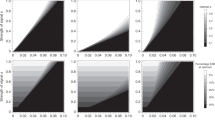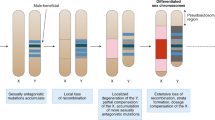Abstract
A broad survey of asexuality in the animal kingdom is sufficient to reject all theories of sex and recombination except two: the Red Queen and the Tangled Bank1,2. The Red Queen theory states that an organism's biotic environment tends to be 'contrary'3, consistently evolving to the detriment of the organism; sex and recombination result in progeny genetically distinct from their parents and grandparents and thus less susceptible to the antagonistic advances made during the previous generations, particularly by their parasites1,4,5. The alternative theory, the Tangled Bank, states that sex and recombination function to diversify the progeny from each other, thus reducing competition between them1,6. An extensive survey of mammalian recombination shows that the total number of chiasmata in excess of one per bivalent is strongly correlated with generation time but uncorrelated with fecundity. We conclude that crossing-over may function to combat antagonists with short generation times but does not function to reduce sib competition. Chromosome number is selectively neutral with respect to these factors.
This is a preview of subscription content, access via your institution
Access options
Subscribe to this journal
Receive 51 print issues and online access
$199.00 per year
only $3.90 per issue
Buy this article
- Purchase on Springer Link
- Instant access to full article PDF
Prices may be subject to local taxes which are calculated during checkout
Similar content being viewed by others
References
Bell, G. The Masterpiece of Nature: The Evolution and Genetics of Sexuality (Croom Helm, London, 1982).
Bell, G. Experientia 41, 1235–1245 (1985).
Trivers, R. L. Social Evolution (Cummings, Menlo Park, 1985).
Jaenike, J. Evol. Theory 3, 191–194 (1978).
Hamilton, W. D. Oikos 35, 282–290 (1980).
Ghiselin, M. T. The Economy of Nature and the Evolution of Sex (University of California, Berkeley, 1974).
Bremmerman, H. J. J. theor. Biol. 87, 671–702 (1980).
Hamilton, W. D. in Population Biology of Infectious Disease Agents (eds Anderson, R. M. & May, R. M.) 269–296 (Springer, Berlin, 1982).
Tooby, J. J. theor. Biol. 97, 557–576 (1982).
Maynard Smith, J. J. theor. Biol. 63, 245–258 (1976).
Eisenberg, J. F. The Mammalian Radiations: An Analysis of Trends in Evolution, Adaptation, and Behaviour (University of Chicago, 1981).
Patton, J. L. & Sherwood, S. W. A. Rev. Ecol. Syst. 14, 139–158 (1983).
White, M. J. D. in Cytotaxonomy and Vertebrate Evolution (eds Chiarelli, A. B. & Capanna, E.) 95–128 (Academic, London, 1973).
Wilson, A. C., Bush, G. L., Case, S. M. & King, M.-C. Proc. natn. Acad. Sci. U.S.A. 72, 5061–5065 (1975).
Williams, G. C. Adaptation and Natural Selection: A Critique of Some Current Evolutionary Thought (Princeton University, 1966).
Mather, K. Biol. Rev. 13, 252–292 (1938).
Searle, A. G., Berry, R. J. & Beechey, C. V. Mutat. Res. 9, 137–140 (1970).
Hultén, M. Hereditas 76, 55–78 (1974).
Blueweiss, L. et al. Oecologia 37, 257–272 (1978).
Bell, G. in The Origin and Evolution of Sex (eds Halvorson, H. O., Sager, R., Monroy, A. & Segal, S.) 221–256 (Liss, New York, 1985).
Rees, H. & Dale, P. J. Chromosoma 47, 335–351 (1974).
Hill, W. G. & Robertson, A. Genet. Res. 8, 269–294 (1966).
Thompson, V. Evol. Theory, 1, 131–156 (1976).
Williams, G. C. Sex and Evolution (Princeton University, 1975).
Author information
Authors and Affiliations
Rights and permissions
About this article
Cite this article
Burt, A., Bell, G. Mammalian chiasma frequencies as a test of two theories of recombination. Nature 326, 803–805 (1987). https://doi.org/10.1038/326803a0
Received:
Accepted:
Published:
Issue Date:
DOI: https://doi.org/10.1038/326803a0
This article is cited by
-
Directional selection coupled with kin selection favors the establishment of senescence
BMC Biology (2023)
-
Recombination rates in pigs differ between breeds, sexes and individuals, and are associated with the RNF212, SYCP2, PRDM7, MEI1 and MSH4 loci
Genetics Selection Evolution (2022)
-
Effect of manipulating recombination rates on response to selection in livestock breeding programs
Genetics Selection Evolution (2016)
-
The Red Queen’s Race: An Experimental Card Game to Teach Coevolution
Evolution: Education and Outreach (2015)
-
Dynamic evolution of the alpha (α) and beta (β) keratins has accompanied integument diversification and the adaptation of birds into novel lifestyles
BMC Evolutionary Biology (2014)
Comments
By submitting a comment you agree to abide by our Terms and Community Guidelines. If you find something abusive or that does not comply with our terms or guidelines please flag it as inappropriate.



